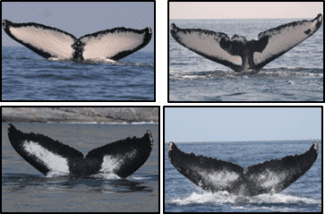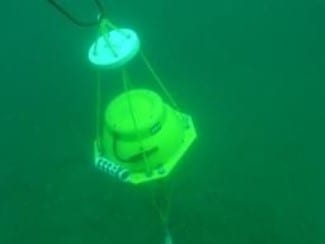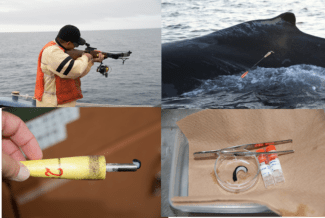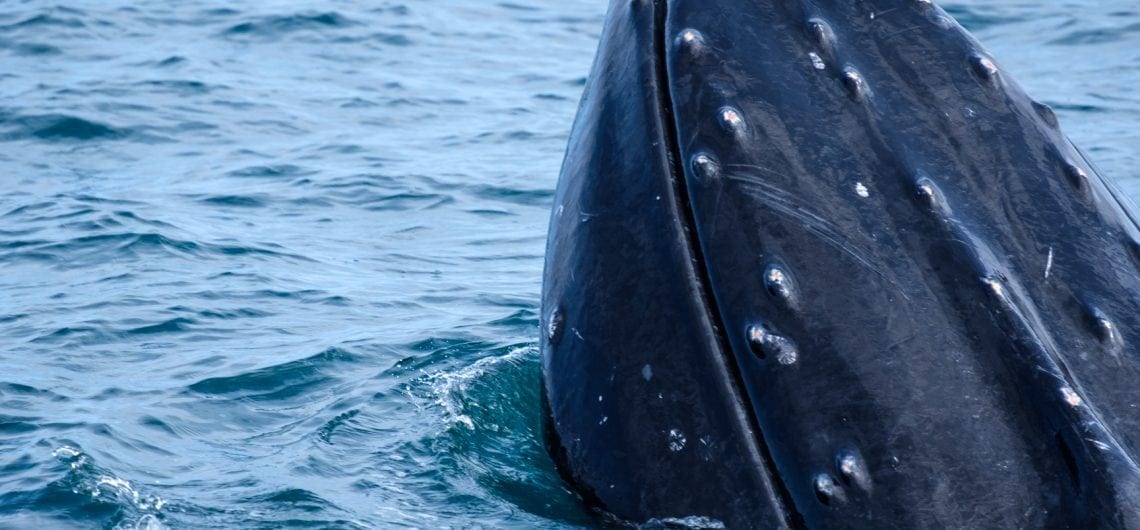What does the latest science and research reveal about Humpback whales?
“Megaptera novaeangliae” or the Humpback whale, has definitely increased in numbers on its migratory path past the Sunshine Coast, but what do we know about these creatures and how?
They are probably the most watched and well studied species of whale. With a group of dedicated students and marine biologists joining Crusader 1 every whale watching season, we are able to assist with this research program.
Dr. Olaf Meynecke from “Humpbacks and Highrises”, along with many organisations all over the world, are contributing to the growing body of research, conservation and management of these majestic creatures.
Identification:

A variety of methods has been used in the past to study whale biology, ecology and evolution. Boat surveys study distribution and habitat use, but they are not reliable 24/7, whereas photo identification helps recognise individual whales by their unique serrations and patterns. Just as Migaloo isn’t hard to spot, so too, thousands of whales have now been tracked using their distinct features. Because humpbacks are so active in their “surface behaviour”– leaping clear out of the water, flipper and tail slapping – they are easily photographed and identified from year to year.
Satellite tagging and time-depth recorders
Satellite tagging and time-depth recorders are other methods (attaching small devices that send the whales’ GPS position to satellite receivers) which allow researchers to track their movement, behaviour and migrations over a long period of time. Using time and distance between different transmitted positions, scientists have been able to determine when and where whales are swimming quickly and where they slow down to feed, rest or socialise. Time–depth sensors can measure the depth and duration of whales’ dives and provide important information on their feeding locations and behaviours. Whereas acoustic monitoring is useful when they cannot be visibly observed. Underwater microphones called hydrophones can be used to detect and record whale vocalizations or song.
researchers to track their movement, behaviour and migrations over a long period of time. Using time and distance between different transmitted positions, scientists have been able to determine when and where whales are swimming quickly and where they slow down to feed, rest or socialise. Time–depth sensors can measure the depth and duration of whales’ dives and provide important information on their feeding locations and behaviours. Whereas acoustic monitoring is useful when they cannot be visibly observed. Underwater microphones called hydrophones can be used to detect and record whale vocalizations or song.
Genetic sampling can also be used to collect data
Using a hollow tipped dart that collects a small plug of skin and blubber from the whale the sample can help determine the sex and relationship it has to other whales in the group. It can recognise whether it is a parent, offspring or sibling and whether the group are related to a  neighbouring pod or whether they comprise a discrete or isolated population.
neighbouring pod or whether they comprise a discrete or isolated population.
Through the use of such devices, some amazing new discoveries have been documented. Robert Pitman, a marine ecologist, using satellite tags has collected evidence to prove that whales migrate from the cold Antarctic seas so they can moult and therefore avoid the build up of potentially harmful bacteria on their skin. . “You can track humpback whales migrating up Australia’s eastern coast just by following the trail of raining epidermal cells they’re shedding,” Pitman says.
Other forms of research
Dr Vanessa Pirotta, a Macquarie University Marine Biologist has used a waterproof drone fitted with a petri dish to collect samples from humpback’s snot to do health checks and even identify if whales are pregnant, based on blowhole sprays. By collecting these fresh samples, rather than those from stranded or dead whales, is proving to be more effective, non invasive and safer.
Cameras on the backs of baby humpbacks have now captured a rare glimpse of mothers nursing their calves – a sight rarely visible on the surface. In addition to a camera, the suction-cup tags also carry an acoustic recorder, depth sensor and accelerometer, which together, collect data on the behaviour, movement and breathing patterns of the whales.
And in the latest research that relates to climate change, Antarctic scientists are looking at the role whale poo plays in keeping ocean acidity levels low enough to allow marine life to survive and thrive. It seems that whale faeces helps absorb carbon dioxide on the sea bed and might help keep acidification in check.
The specialist equipment, constant monitoring and highly experienced personnel are all part of the whale watching season here on the Sunshine Coast. Their research plays a major role in helping to determine more knowledge about these majestic creatures as well as how best to protect and conserve the whales that visit how waters.
If you’d like the chance to experience the magic of humpback newborns playing alongside their parents this whale watching season, and also the older humpbacks breaching and tail slapping, feel free to give us a call on 0412 155 814 or email us on – info@sunshinecoastafloat.com.au. You can also book online if you wish.




